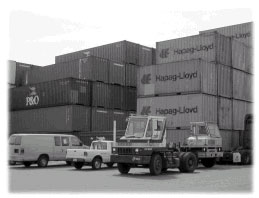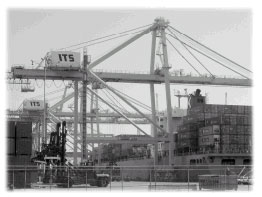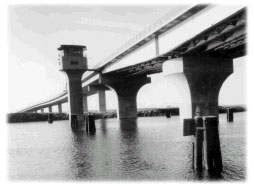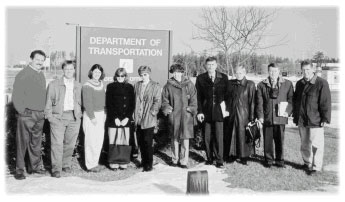U.S. Department of Transportation
Federal Highway Administration
1200 New Jersey Avenue, SE
Washington, DC 20590
202-366-4000
Federal Highway Administration Research and Technology
Coordinating, Developing, and Delivering Highway Transportation Innovations
|
Research & Technology Transporter This newsletter is an archived publication and may contain dated technical, contact, and link information. |
|
| Publication Number: N/A Date: March 2002 |
Publication Date: March 2002
|
In 2000, more than 4,739 pedestrians were killed and 78,000 were injured in U.S. motor vehicle crashes. These figures point toward a need to increase pedestrian and bicycle safety and mobility. Whether it's making improvements in crosswalks, sidewalks, walkways and pedestrian technologies, or expanding public education and safety programs, Federal Highway Administration's (FHWA) Pedestrian and Bicycle Safety Research Program strives to pave the way for a more walkable future.
A part of a larger FHWA study, Evaluation of Pedestrian Facilities, the Pedestrian and Bicycle Safety Research Program recently published the Pedestrian Facilities Users Guide - Providing Safety and Mobility, to help transportation engineers, planners, and safety professionals make cities more pedestrian-friendly and safe. The Guide offers plenty of useful information about safe walking environments, and highlights the main causes of pedestrian crashes and strategies for countering them.
 |
 |
| This intersection illustrates the use of several safe features including the "Walking Pedestrian" signal and a pedestrian crosswalk. Notice that several of the pedestrians crossing the street fail to remain within the "safe" crossing zone. | This photo shows pedestrians standing on a depressed median, four-lane separator. It might be safer under certain traffic conditions for the pedestrians to wait for the light to change on the corner of the road. |
Pedestrian Facilities Users Guide - Providing Safety and Mobility is also a tool for enabling professionals to identify pedestrian safety needs within roadway rights-of-way. It defines 13 pedestrian crash-type groupings and the types of possible safety countermeasures for each group in different crash situations. Along with this information, the guide also includes the purpose, considerations, and estimated costs for each countermeasure.
The Pedestrian Facilities Users Guide also supplies a number of case studies which highlight success stories in Asheville, NC; Cambridge, MA; Boulder, CO; Fort Pierce, FL; and Portland, OR; including traffic calming, reducing speed through neighborhoods, revitalizing downtown areas, and improving safety for children near schools.
A printed version is not yet available; however, the Pedestrian Facilities Users Guide, is currently available online by visiting the following Web site: http://safety.fhwa.dot.gov/ped_bike/docs/peduserguide.pdf
Ann Do 202-493-3319 ann.do@fhwa.dot.gov
Despite the efforts of transportation officials to create safe and mobile work zones, multiple injuries and fatalities continue to occur across the country. Recent years have demonstrated an alarming upward trend in work-zone related automobile crashes. In 2000, alone, there were an estimated 1,093 fatalities in work zones.
To focus attention on the need for work zone safety and mobility, Federal Highway Administration, State DOTs, and safety partners will host the third annual National Work Zone Awareness Week from April 8-12, 2002. The theme for this year's campaign is Roadways Keep America Moving - Drive Safely in Work Zones, which organizers hope will increase driver awareness in work zones, thereby improving safety for both motorists and highway workers.
The kick-off on Tuesday, April 9, 2002 will feature a brief presentation by Federal Highway Administrator Mary Peters held at a work zone site located at the I-95/I-495 Interchange at Ritchie Marlboro Road in Prince George's County, Maryland. There will also be a ceremonial unveiling of a memorial wall in honor of those who lost their lives in work zones. The memorial is a portable wall that can be transported from location to location. For further information about this event, contact
Ann Walls 202-366-6836
According to accident statistics, intersections are the location of more than 45 percent of all reported crashes. Predicting potential driver behavior or traffic collisions is difficult because existing technology depends highly on statistics gathered after a number of crashes have already occurred. Crash models are contingent upon retrospective crash information; the crash statistics may not provide a large enough sample; and traffic engineers may not have the right type of information to correctly represent specific conditions on a road or at an intersection. Additionally, crash models involving realistic conditions - such as rush hour, traffic flow, bottlenecks, etc. - may not be accurately portrayed. Relying solely on crash statistics for crash modeling can be costly - in human safety, and infrastructure investment.
To be proactive, engineers at Federal Highway Administration's (FHWA) Office of Safety Research and Development (HRDS) have initiated research to find "surrogate safety measures" in traffic simulation models that they can use in place of, or in addition to, actual accident data. Quantifiable conflict measurements that might lead to collisions include: expected time for two vehicles to collide if they remain at their present speeds and paths; the time lapse between cars; amount of space necessary for changing lanes; braking or deceleration to avoid a collision, etc. In performing this study, researchers must first identify and define appropriate and measurable surrogate actions or events, then recommend applicability to existing traffic simulation models for intersections. They must also develop functional requirements and logic for the simulation software, which depicts safety measures for intersections.
After estimating these surrogate safety measures, HRDS plans to make the logic available for implementation by software vendors. This study will involve the following:
Phase I
Phase II
Once incorporated, the intersection logic will enable safety engineers and roadway designers to better evaluate the safety and mobility of both conventional and innovative roadway and intersection designs and treatments, since the new tools will enable them to simulate more encompassing and realistic conditions. A contract was awarded for Phase I of the project, scheduled for completion in December 2002.
Joe Bared 202-493-3314 joe.bared@fhwa.dot.gov
 |
| Intersections are one of the most high-risk traffic spots in America. This 10-lane example shows several potential safety problems such as unmarked lanes across the center of the intersection and cars turning into lanes being crossed by pedestrians. |
Many businesses and organizations across America rely on "just-in-time" freight transfer and management to help cut storage costs; streamline manufacturing; shorten time-to-market; and speed up delivery processes. Increases and delays in freight movement across the U.S. create juggling challenges for freight handlers, port terminal managers, and transportation agencies. A traffic jam, auto crash, construction work zone, major public event, or inclement weather can wreak havoc on the system, as freight hubs shuffle traffic, and cargo through the loading, unloading, discharge, and storage processes. The transportation industry seeks better tools that will enable them to manage their day-to-day freight and port operations.
In November 2001, Federal Highway Administration (FHWA) awarded two operational test contracts, resulting from cooperative partnerships between public and private organizations through the Intermodal Freight Technology Working Group (IFTWG). The new working group was formed to examine how technology could increase the efficiency of freight transportation operations and the tests will help them understand tracking and location technology requirements. They will use Intelligent Transportation Systems (ITS) technology to assist in transporting and monitoring freight. Both tests seek to provide State and local agencies with better and timelier information, for helping freight hubs prevent or lessen port congestion and delays.
Asset and Cargo Visibility Test will focus on transmitting freight information and movement data about container chassis in and out of a port terminal. It will include chassis staging and availability information, plus maintenance information that will help reduce the movements of unsafe chassis. If successful, it hopes to enhance the "freight information highway" by providing freight and cargo information in a standardized format and linking to a backbone information system. Monitoring chassis movements should make it easier to manage containers in terminal yards.
Terminal Dray Operations Test plans to help improve the cross-town freight movement within the Chicago terminal area - which can normally take three to five days. The test will focus on transmitting data and information during drayage operations (a dray is any vehicle used to haul freight) while in and between delivery ports. Port of Tacoma, in Tacoma, WA, will gather container and loading information and share it with the Chicago terminal and drayage operations teams. Chicago will stage trucks to pick up containers as soon as they are available for movement to another rail line or to an end-destination customer.
 |
 |
| At this freight hub, hundreds of containers wait to be loaded onto transportation vehicles at Port Newark. | Huge cranes at the Port of Long Beach are unloading the cargo on this super ship. |
The IFTWG plans to continue testing emerging technology and wants to establish the business case for technology applications, which improve transportation operations. For more information, visit the FHWA Operations Core Business Unit (CBU) Web site at www.ops.fhwa.dot.gov.
Mike Onder 202-366-2639 michael.onder@fhwa.dot.gov
Lee Jackson 202-366-4415 lee.jackson@fhwa.dot.gov
ITS America's vision for Intelligent Transportation Systems (ITS) includes operational strategies to improve safety, security, mobility, the economy, and the environment in the decade ahead.
The Transportation Equity Act for the 21st Century (TEA-21) mandated development of the long-range Intelligent Transportation Systems research and development plan, including a "road map" (or outline) of current projects and programs. The U.S. Department of Transportation (DOT) chose to implement TEA-21's requirements with two separate documents: the 5-year program plan, which delineates current programs and projects, and the 10-year research and program plan. DOT developed the 5-year program and selected ITS America - a federal advisory committee - to develop the 10-year plan.
ITS America recently completed the plan, now called The National Intelligent Transportation Systems Program Plan: A Ten-Year Vision, and delivered it to DOT. Now the Department will review the work that has been done and identify the critical needs and focus areas. Besides the ITS operational strategies to improve safety, security, mobility, the economy, and the environment over the next ten years, it examines the needs for supporting ITS deployment. Primary themes of the program plan focus on social, institutional, and political issues, and include the following goals:
The 10-year program plan also identifies the need for an "infostructure" - an electronic information network that works in concert with the physical transportation infrastructure. It also calls for introducing ITS technologies into the institutional framework of surface transportation and stresses the need for continued research and development of the intelligent vehicle.
Even though most of the work on the ITS Program Plan was completed prior to Sept. 11, the overall importance of national security is clearly articulated in its first pages. Many current technologies - weigh-in-motion technology, spatial geolocation, and incident detection systems - can be used as part of homeland defense systems. To address the role of ITS in maintaining and ensuring homeland security, DOT and ITS America are assembling resources to develop an update to the Program Plan, and plan to publish the update in 2002. See The National Intelligent Transportation Systems Program Plan: A Ten-Year Vision on the Web at www.itsa.org/.
Susan Slye 202-366-1068 susan.slye@fhwa.dot.gov
By building bridges across international waters, the U.S. transportation industry decreases research and development costs, expands their knowledge base of new techniques, and takes advantage of groundbreaking advances and best practices from around the world. Through international scans, the American transportation community learns from our neighbors about their successes and failures; avoids duplicative research and development; and accelerates application and adoption efforts in the U.S. transportation system.
The Federal Highway Administration (FHWA) and the American Association of State Highway and Transportation Officials (AASHTO) jointly sponsored the Pavement Preservation International Scanning Tour - which linked U.S. highway experts with their overseas counterparts to learn about the newest approaches to transportation policy, operations, planning, design, construction, and maintenance. A recent international scan focused on preserving highway and road pavements.
Traditionally, highway agencies allowed the ride quality and structural condition of their pavements to deteriorate before taking rehabilitative steps. Pavement rehabilitation is costly and time consuming, resulting in traffic disruptions and inconvenience to adjacent businesses and residences. In recent years, an increasing number of international highway agencies found that applying a series of low-cost pavement preservation treatments could extend the service lives of their pavements. In principle, this is similar to an ounce of prevention...is less costly than a pound of treatment.
The scanning team identified innovative programs and new treatments for pavement preservation in France, South Africa, and Australia. These types of innovations and practices are a few samples of the results available on the Web:
To view an online summary of the scan, please visit the FHWA's International Technology Web site, at http://www.international.fhwa.dot.gov/links/pubs.cfm.
Hana Maier 202-366-6003 hana.maier@fhwa.dot.gov
 |
| By building bridges across intenational waters, the U.S. saves costs, takes advantage of groundbreaking advances and avoids duplicative research from around the world. |
Every winter, transportation officials in the U.S. and Russia, face a battle against freezing temperatures, snow, and ice - and the effects these elements have on road maintenance; snow removal; damaged and frozen asphalt and concrete rehabilitation; and driver and pedestrian safety during hazardous conditions.
In December 2001, transportation officials from the Tomsk and Kemerovo regions in Siberia (located four time zones east of Moscow) visited and toured the Federal Highway Administration (FHWA) Turner-Fairbank Highway Research Center to discover more about FHWA national research; and they traveled to Minnesota to sign a Memorandum of Understanding with the Minnesota Department of Transportation (DOT). Siberian transportation representatives, and Minnesota transportation representatives found they had similar transportation problems. This joint effort to share knowledge benefits U.S. and Russian citizens, by reducing research duplication efforts. In the long run, international research and technology sharing programs, like this one, will also benefit the U.S. by reducing research and technology deployment times and by saving tax dollars.
The Siberian delegation was interested in a number of FHWA technologies: pavement and asphalt maintenance; pavement life extension; and a training program for publicly and privately employed Siberian highway professionals. In addition, the Siberian delegation wanted to learn more about the FHWA "best practices" in the following areas: production and use of modified asphalt; winter road maintenance; bridge construction and maintenance; methods for working with wet soils and drainage; methods for slope stabilization; and technology transfer resources, methods, and operations for creating a technology transfer (T2) center, based on the U.S. model.
 |
| Transportation officials from Russia and the Minnesota Department of Transportation pose for a group shot in front of the DOT sign. |
This technology sharing is not one-sided - Minnesota DOT transportation officials are particularly interested in a Russian snowplow extender that clears snow from behind guardrails. They believe it could prevent damage to miles of Minnesota guardrail, every winter. Minnesota DOT was also interested in reversible snowplow blades that extend the life of the blade and fully utilize precious steel resources. Another favorite of the Minnesota DOT was Siberia's anti-icing salt that might prove to be more effective and cheaper than anti-icing technology in the U.S.
Since December 2000, FHWA has sponsored this international program, enabling the two transportation departments to share knowledge and potential solutions for fighting the effects of winter. The next phase includes sending two Siberian interns to Minnesota in September 2002. The interns will study Minnesota's financial management of routine summer and winter maintenance and participate in the National Highway Institute's (NHI) Instructor Development Course (IDC). Plans are already in the works for a joint Russian-American seminar on winter maintenance management in December 2002.
Tracy Nichols Busch 202-366-9807 tracy.busch@fhwa.dot.gov
The Transportation Curriculum Coordination Council (TCCC) brings together five regional training and certification groups to improve training opportunities for transportation workers; to develop a national core curriculum for use by any agency; and to build partnerships among State highway agencies and industry associations. TCCC membership includes representatives from the Federal Highway Administration (FHWA); the National Highway Institute (NHI); the American Association of State Highway and Transportation Officials Subcommittees on Construction, Maintenance, and Materials; and representatives from the construction industry. Their main goals are to standardize training; reduce duplicative efforts; and save time and money in developing training materials.
On December 4-5, 2001, the TCCC held their third annual meeting in New Orleans, LA. The meeting featured topics about work activities and accomplishments, and highlighted discussions about assembling a pooled-fund project and developing a Web site. Major features of the Web site will include State programs and contacts; training courses; links to regional training and certification programs; and TCCC events and news. Currently in its initial stages, visitors can visit the new Web site at www.nhi.fhwa.dot.gov/tccc. The TCCC is also compiling an online database of available training from the various regional certification groups.
A number of work items are ongoing or have been completed since the December meeting, such as identifying structural fabrication inspection training opportunities; developing national pollution discharge elimination systems training through the Association of General Contractors; developing training for foundations inspectors; and completing training for the design and implementation of erosion and sediment control. For more information, or to see the latest NHI course updates, visit www.nhi.fhwa.dot.gov.
Christopher Newman 703-235-0524 christopher.newman@fhwa.dot.gov